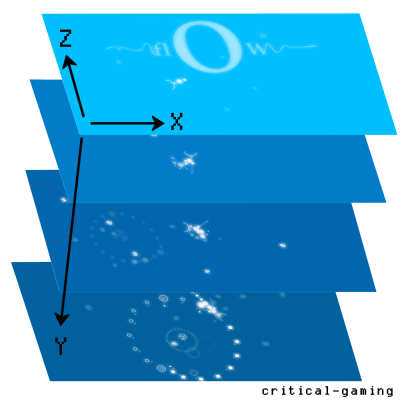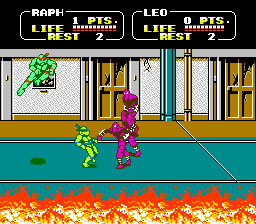Continuing from part 3...
3D Punctuation
Many 3D games don't use all 3 dimensions evenly. For these games, the gameplay is mostly either 2D side-scrolling or 2D top down while only occasionally using the Z or Y axis respectively. I describe such games as punctuating the 3rd dimension. The range for this classification includes games that shift between quantified dimensions to games that fall just short of supporting gameplay dynamics that use every dimension evenly. The best way to go about understanding the distinction between 3D punctuating games and full 3D games is to look at examples that gradually move from one end of the spectrum to the other.
Quantified Dimensions

- flOw: In this game, players swim around in a 2D top down horizontal "slice" of the ocean. By eating special ocean elements, players can move vertically between these slices of the sea. In this way, the player is able to explore every dimension of this game world, yet vertical travel is restricted to separate levels. Play it here.
- LittleBigPlanet: LBP is just the opposite of flOw. Instead of playing in a top down world while punctuating the Y dimension in quantified zones, LBP exists in a side-scrolling world where players punctuate the Z (depth) dimension by switching back and forth between the 3 layers/zones. The biggest difference between these two games is that in LBP ,the Z axis zones are much more integrated into the gameplay. Not only can players switch back and forth between the zones using their MOVE mechanic, but level elements are often designed so that they extend into more than one zone at a time. Also, players can grab point bubbles from any zone, and explosion blast radius affects all three zones. In these ways, the 3D depth of LBP is less separate than in flOw.
Analog 3D with Minimal to Sub Full 3D Gameplay

- Teenage Mutant Ninja Turtles 2 (NES): Players can move in 2 dimensions along the ground; up, down, left, right. To dodge attacks or obstacles, players can jump vertically along the Y axis. Because JUMPing is not a major part of the game (ie. not required for progression) and gravity isn't a key dynamic for the level/enemy design, this 3rd dimension of vertical space only serves to punctuate what would otherwise be 2D top down gameplay. Play it here.
- Mario Strikers Charged (Wii): In this soccer-hockey hybrid, players run around the field in top down gameplay fashion. Certain characters doing certain moves have the ability to jump up into the air (along the Y axis). When this happens, the game uses the 3D hitboxes to determine if these jumps avoid oncoming tackles or incoming projectiles in real time. In addition to kicking the ball along the ground, the ball can be kicked into the air via lob passes, shots on the goal, and lobs into the goal. Because everything on the field can interact with each other according to an accurately drawn hitbox, small differences in height can make a big difference in the gameplay. For these reasons, Mario Strikers Charged uses the 3rd dimension to enhance and punctuate gameplay in a more organic and dyanmic way than in TMNT2 (above). Watch a high level 1v1 match here.
- Pikmin 1 & 2 (GCN): Though the presentation in the Pikmin series is top down (or very nearly so) the gameplay is surprisingly 3 dimensional. While traversing the land, players have to maneuver up, over, around, and under objects, ramps, hills, enemy bodies, etc. The multilayered and bumpy terrain punctuate the 3D game space. While walking up a small hill or climbing down a small slanted surface would ordinarily be a very minimal use of 3D space, in Pikmin the verticality of the Y axis and gravity are a key dynamic to the level and enemy design. The player avatar in Pikmin is limited on where he/she can go by the level obstacles/design. Because these obstacles exist in 3D space with 3D hitboxes, it's possible to throw something up and over them. In this case, players have an army of Pikmin at their disposal to throw around and use in a variety of ways. Whether it's throwing Pikmin on the backs of large enemies or up and over ledges to grab treasure Pikmin uses 3D space quite dynamically. Putting all the parts together, Pikmin is a 3D terrain top down RTS that has the flexibility to pull the perspective in close and to the side in order to throw Pikmin, the functional equivalent of a JUMP mechanic.
Full 3D Gameplay
Instead of combining a variety of largely independent design layers to create 3D gameplay like with the examples above, the core dynamics of the following games depend on 3D interactions of 3D objects and 3D space.
- Super Mario 64 (video)/Sunshine (video)/Galaxy (video 1, video 2): All three of these games are about exploring 3D spaces by using Mario's gravity defying JUMP. SM64 established the basic 3D platforming mechanics and 3D level design. Sunshine extended the core mechanics by giving Mario a water "jet pack" that allows him to hover, race forward, and rocket upward to navigate the 3D areas in new ways. Finally, Galaxy innovates on the gravity dynamic itself. By putting Mario out in space running around on little planetoids, gravity becomes local, variable, interactive, and almost tangible. In this game, absolute direction is irrelevant. After all, when running away from a target can quickly change into running towards it, or when jumping up can so easily change into falling down, motion is only relative to where you're going next.
- Echochrome (PSN) (video): Taking the limitations of 3D space and perspective and incorporating this engaging quality of the 3rd dimension into the core dynamic of this puzzle game, Echochrome is a perfect example of 3D dependant gameplay and 3D interpretation. The gameplay revolves around manipulating the perspective of these 3D structures to reveal and obscure parts of the level. When obscured, the game functions like these parts don't exist. When positioned just right, 3D space is bent to function like it appears from a 2D perspective.
- Super Monkey Ball 1 (video) & 2 (video) (GCN): Guiding the monkeys through the levels in this game requires players to tilt the gameworld. Instead of moving the avatar's around, players manipulate the world in a 3D way; tilting. Because of this design, every level in the game (even the flat ones) are moving around in full 3D space. These controls/mechanics are not to mention the intricate ball physics which allow players to JUMP, BOUNCE, and CATCH the monkey balls all by manipulating the tilt of the levels. Compared to the first game, Super Monkey Ball 2's levels are designed with a lot more verticality (y axis) in 3D space.
For all games that aren't full 3D gameplay games, understanding the 3D design is only a matter of understanding how the underlying 2D systems are put together and/or how the 3rd dimension is punctuated. But there's another important issue that has plague 3D game design that must be discussed. If perspective is a new dynamic for 3D game spaces, then a game's camera design can make or break the gameplay. In part 5, I'll uncover why camera design is so inherently tricky, and what designers have done to simplify 3D back into 2D.